| |


| |
Figure 1. World Energy Consumption by Fuel
Type
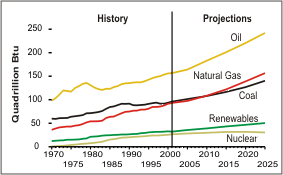
|
|
| |
Figure 2. World Energy Consumption by Region
![Figure 2. This figure is also a line graph for world energy consumption by region (industrialized, developing, and EE/FSU [East Europe and Former Soviet Union] countries). The graph shows history and projection data from 1970-2025. For further information, contact: National Energy Information Center, (202) 586-8800.](/peth04/20041107202119im_/http://www.eia.doe.gov/bookshelf/brochures/ieo2004/images/fig%202.gif)
|
|
| |
Table 1.
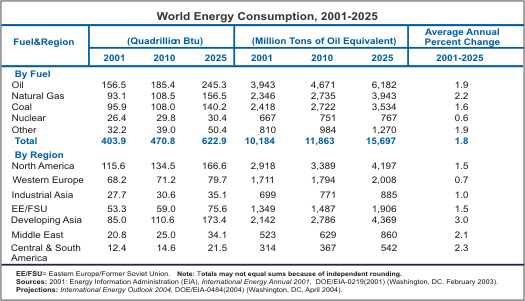
|
| |
Table 2.
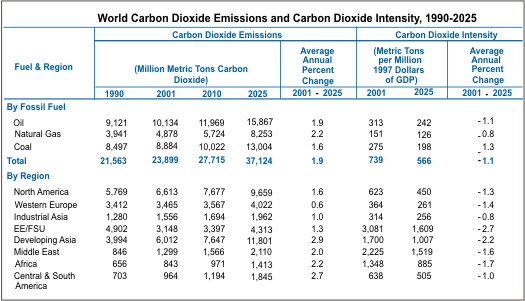
|
| |
Figure 3. World Carbon Dioxide
Emissions by
Region

|
-
Much of the growth in carbon dioxide emissions
is expected in the developing world, accom-panying the large
increases in fossil fuel use projected for the region’s
emerging economies. At the end of the forecast horizon, emissions
in the developing world are expected to exceed those of the
industrialized countries.
|
| |
Figure 4. Carbon Dioxide Intensity by Selected
Countries and Regions
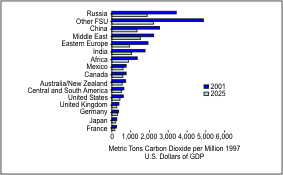
|
-
World carbon dioxide intensity has improved
(decreased) substantially over the past three decades, falling
from 1,100 metric tons per million 1997 dollars of GDP in 1970
to 739 metric tons per million 1997 dollars of GDP in 2001.
-
On a regional basis, the most rapid rates
of improvement for carbon dioxide intensity are projected for
Russia and the other countries of the former Soviet Union (FSU).
In the FSU, economic recovery from the upheaval of the early
1990s, along with the replacement of old, inefficient capital
stock is expected to result in a 48 percent decline in carbon
dioxide intensity between 2001 and 2025.
|
| |
Figure 5. World Oil Prices
in Three Cases

|
- Short-term price movements do not affect the mid-term price
projections, 5 to 10 years out. After 2004, prices fall to $25
per barrel in 2002 dollars and then rise slowly to 2025, reaching
$27 per barrel in 2002 dollars (in nominal dollars $51 per barrel).
|
| |
Figure 6. World Oil Consumption
and Production
by Region
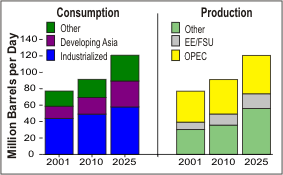
|
-
Oil use is projected to rise to 121 million
barrels per day by 2025. Most of this increase occurs in the
transportation sector. In the developing count-ries, other oil
uses also expand as emerging economies switch away from traditional
fuels, like wood burning for home heating and cooking, to diesel
genera-tors and to fuel petrochemical feedstock industries.
- OPEC’s share of world oil supply is projected to increase
significantly over the forecast horizon. Nearly 60 percent of
the increase in world oil demand over the next two decades is
expected to be supplied by OPEC.
|
|
For Further Information, Contact:
The National Energy
Information Center
Washington, DC 20585
Telephone: (202)586-8800
E-Mail: infoctr@eia.doe.gov
|
|
|




![Figure 2. This figure is also a line graph for world energy consumption by region (industrialized, developing, and EE/FSU [East Europe and Former Soviet Union] countries). The graph shows history and projection data from 1970-2025. For further information, contact: National Energy Information Center, (202) 586-8800.](/peth04/20041107202119im_/http://www.eia.doe.gov/bookshelf/brochures/ieo2004/images/fig%202.gif)





